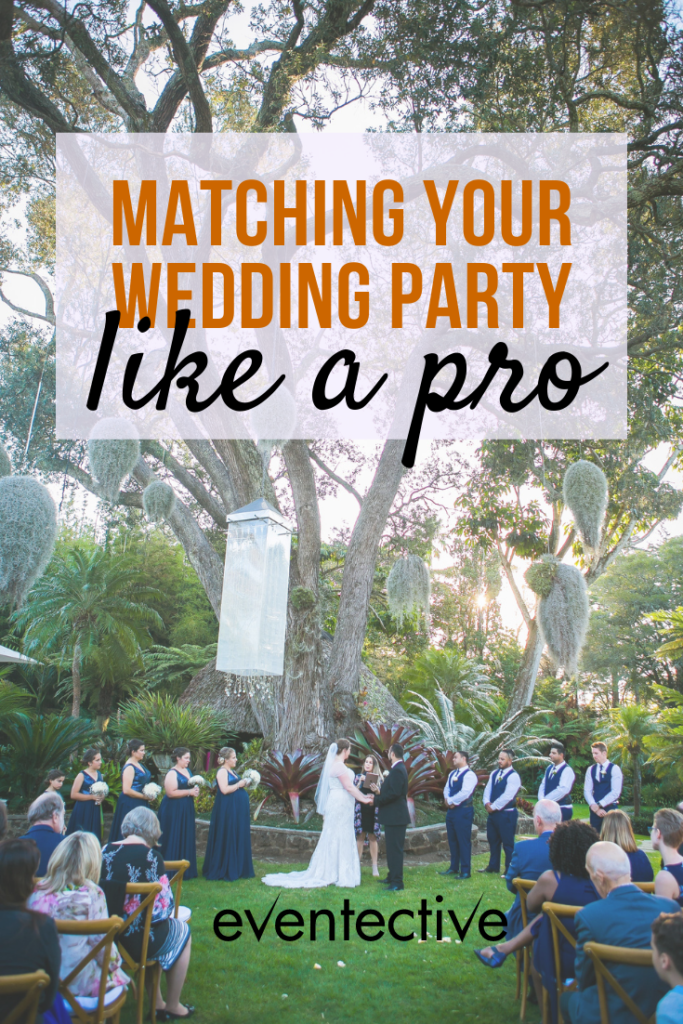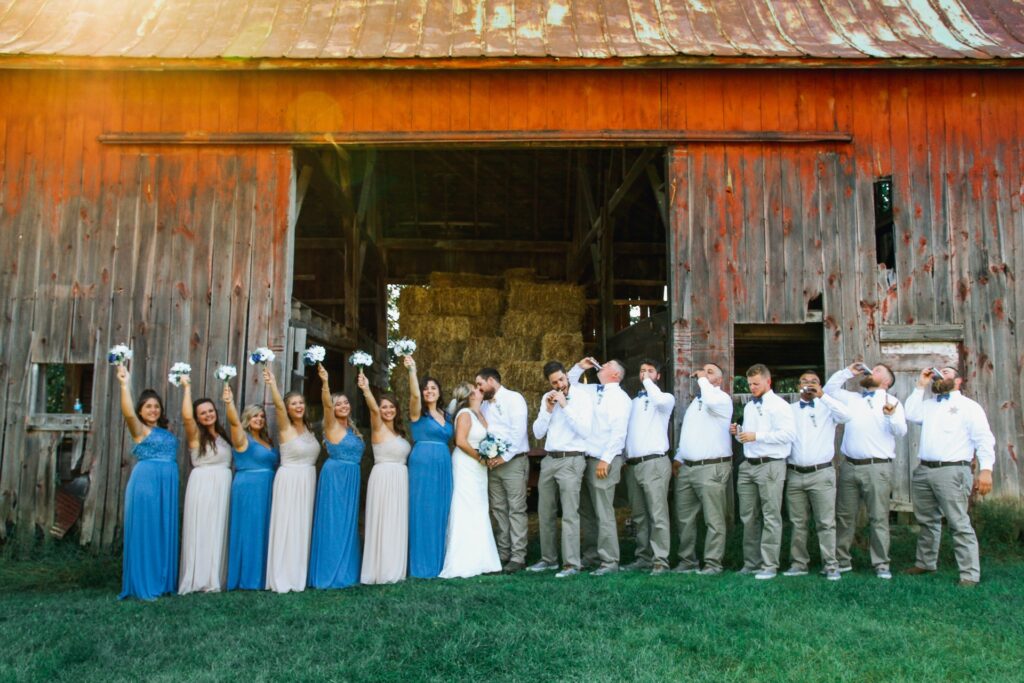
There are a lot of things that will match at your wedding—or at very least complement each other. For example, your napkins may complement your flowers, and the cake may match the centerpieces. When you choose a color palette or theme for your wedding and stick with it, the end result is one grand, cohesive event that takes your guests’ breath away. Well, matching your wedding party is a big piece of that cohesive puzzle.
Of course, we all know the happy couple is the star of the show (followed closely by a stunning venue!). But the wedding party has a major role during the ceremony, too. For starters, guests typically see the wedding party first. Sometimes, half the wedding party is already waiting at the altar when the ceremony begins, while other times the entire wedding party walks down the aisle together. Either way, you’ll see the whole wedding party before you see the bride or groom walk down the aisle. They’ll also be in lots of photos and introduced at the beginning of the reception.
All in all, the attendants play a big role in your special day—so matching your wedding party is an important part of a cohesive celebration. But as with most wedding decisions, you have plenty of options. You can choose how much everyone should match and who everyone should match with, too. There’s no wrong way to match or complement your wedding party, and in this post, we’ll explore some of the many ways to do just that.
Who’s in the Wedding Party?

Typically, a wedding party consists of the happy couple’s closest friends and family members. You may choose to separate your wedding party by gender or by sides of the aisle. For most weddings, each partner chooses the same number of attendants, so everything is balanced. However, it’s your wedding, so you should create the wedding party that you want, regardless of tradition or common practice.
What Does the Wedding Party Wear?
Once again, we’re going to explore what is typically done. (But we always encourage you to stay true to yourself on such an important day.) In general, the wedding party wears semi-formal or formal attire. That includes dresses, skirts, and tuxes. Most traditionally, each half of the wedding party matched: If the attendants wore dresses, they all wore the same style and color dress. On the other hand, if the attendants wore suits, those suits matched—down to the ties.
But in recent years, we’ve seen a lot more variation in the wedding party. For example, sometimes attendants choose their own dresses within a color palette. Or they all wear matching skirts with their own shirt picked out—or vice versa. There seems to be less flexibility with suits and tuxes, though. In some cases, attendants can choose their own sport coat or tie color, but their attire has stayed more traditional.
How Do You Match the Wedding Party?

No matter what your attendants wear, matching your wedding party is still important. You don’t want everyone to be at the altar in contrasting colors and patterns; that’s just going to distract the guests and take away from your wedding theme. So let’s cover some important elements of matching your wedding party, including how to create a cohesive look.
Use the same materials
If your attendants are choosing their own coats or skirts or shoes—anything, really—stick to the same materials. For example, you don’t want a mix of chiffon dresses and silk dresses because the different materials change the color slightly. Navy blue is a little darker in chiffon than it is in silk, so if one attendant is in silk, they will stand out. When you use the same materials, you can match shades better. Even if you’re creating a ombré look with your wedding party, using the same materials will ensure that no one stands out more than the others.
Match tie colors with dress colors

If you want a really easy way to blend the two halves of the wedding party, pick one element from each side to match in color. Most commonly, the dresses match the ties or suspenders. So anyone in a suit has a green tie that matches the green dresses. This also works with ombré or rainbow wedding parties—instead of being all the same shade, you would match one tie with one dress for the whole party.
Give everyone the same flowers
Maybe the best man is the only one wearing a jacket, so their suspenders aren’t visible or you’re keeping it casual with no jackets or ties at all. Then you can give every attendant the same flowers. Whether you use bouquets, boutineers, corsages, or any combination of the three—just use the same flowers for all of them. For a truly unified look, these flowers should also match the wedding bouquet and any flower centerpieces or decorations throughout the celebration.
Keep it uniform

Matching the wedding party doesn’t mean that both halves have to match something in color. Instead, you can simply have all the dresses in the same style and color and all the suits in the same style and color—even if they’re different from each other. This will result in a more classic look, but your wedding party will still complement each other well in photos and at the altar. There doesn’t need to be any overlap if you don’t want it!
Conclusion
There are plenty of ways to match your wedding party, but the good news is that none of them have to be complicated! You can blend the two halves of the wedding party with matching dresses and ties or even just the same flowers. The most important thing is that your colors don’t clash with you or with each other. And if you’re not sure what to match, visit a store that offers both dresses and suits so you can see your options up close before committing.
What’s your favorite way to match the wedding party? Do you prefer a subtle look or a bolder pairing?

